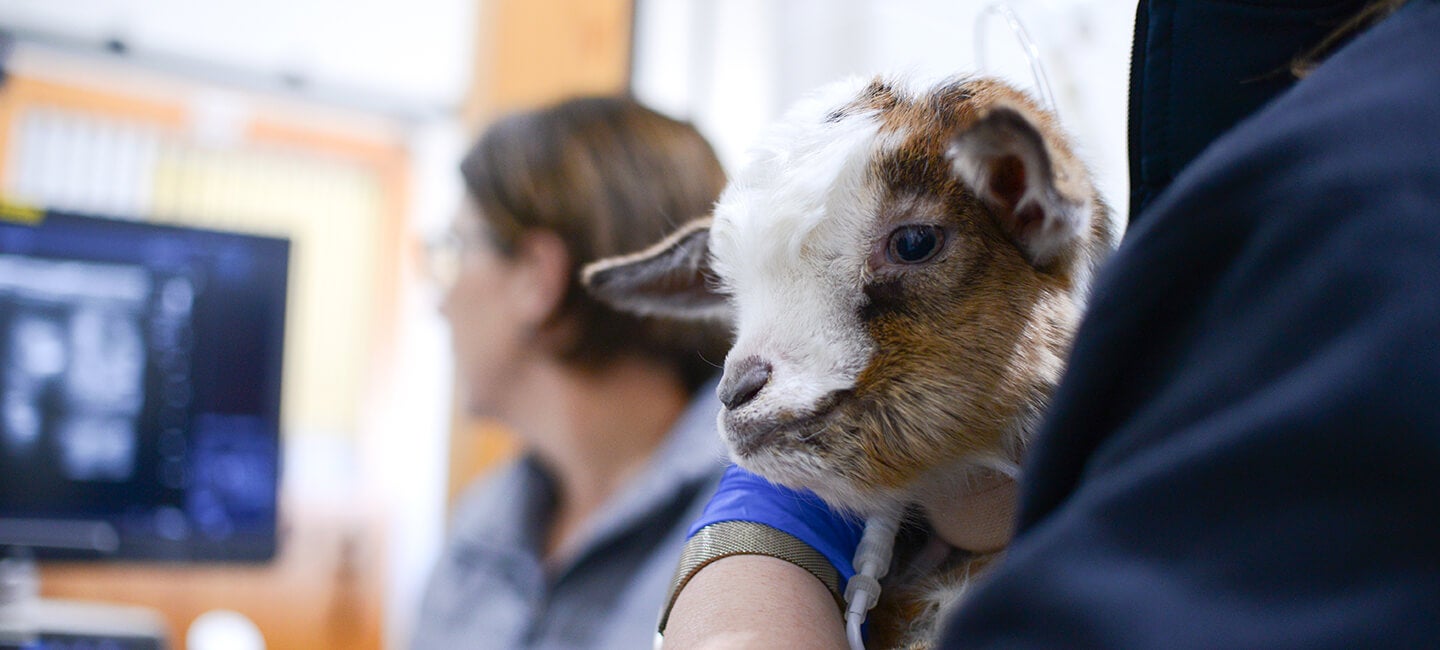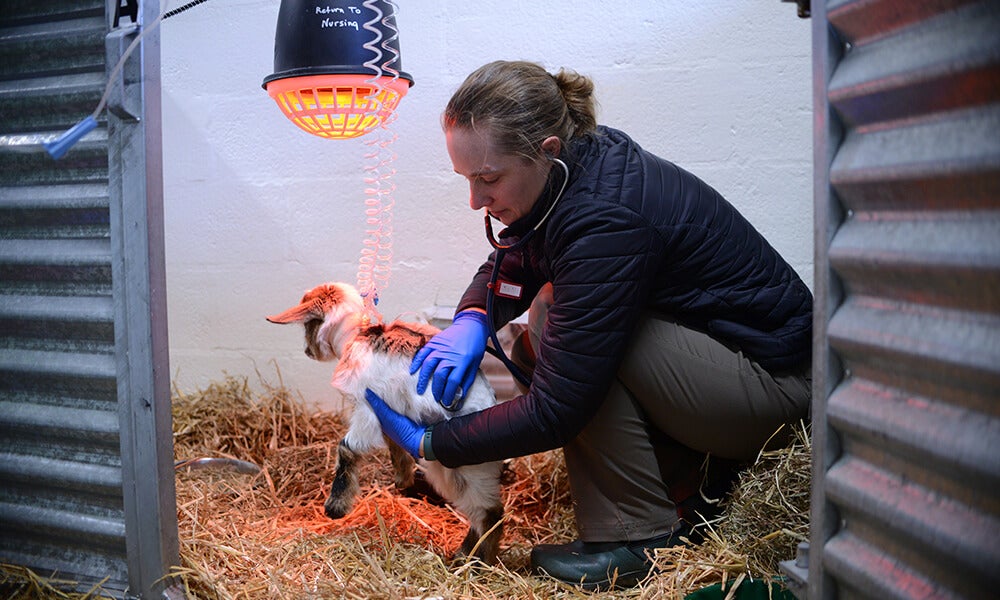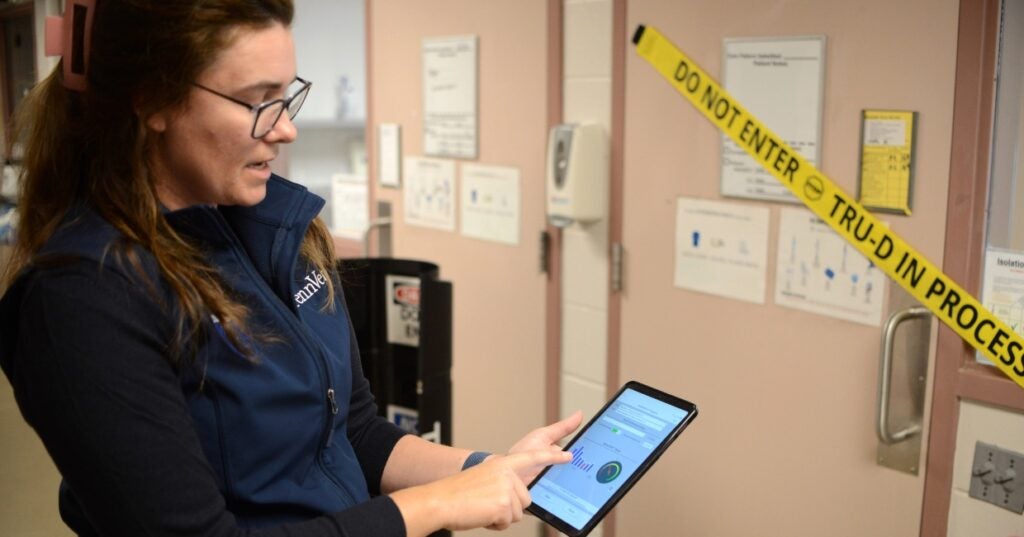No kid-ing around: Kale’s comeback

One March morning, while at work, Allyson Bloodgood checked the remote camera on her farm. What she saw made her stomach drop. One of Bloodgood’s one-month-old goat kids, Cabbage, had collapsed.
She rushed home, loaded Cabbage and his brother Kale, as a companion, into the car. They headed straight to Penn Vet’s New Bolton Center.
The brothers had a difficult start to life. Their mother died shortly after giving birth, and neither kid took well to the bottle. Bloodgood even bought another doe to adopt and feed them, but still, the little ones struggled. Nevertheless, she wasn’t prepared to see Cabbage so ill.
“We made it to New Bolton Center,” Bloodgood said. “Cabbage’s care team did everything they could, but sadly, he passed shortly after we arrived. Thankfully, they also examined Kale, even though he looked fine. Turns out, he was headed toward critical condition as well.”
The smaller, quieter Kale immediately became the focus of everyone’s attention.
Unseen dangers
Kale appeared healthy. He drank from a bottle and was alert and active. But point-of-care bloodwork told a different story.
“Kale’s white blood cell count and blood sugar were low, both red flags in a neonate,” said Kavita Shroff, VMD, an internal medicine resident at Penn Vet. “With young animals, even the smallest abnormalities can signal something serious, and time is of the essence — things can go downhill quickly.”

The decreased white blood cells were concerning for a potential infection. Lungs, joints, and the gastrointestinal system and umbilicus are all places where infections can easily establish themselves in neonatal animals.
Kale was hospitalized and started on antibiotics. But, after a few days, his condition worsened even though follow-up blood work showed his white blood count had normalized.
“We conducted more diagnostics,” said Joy Tomlinson, DVM, PhD, DACVIM, assistant professor of large animal medicine.
Digestive detour
An ultrasound revealed the cause of Kale’s troubles: He was “rumen drinking.”

Goats have four stomach compartments—rumen, reticulum, omasum, and abomasum. In young goats, milk normally bypasses the rumen and goes straight to the abomasum, where it can be properly digested. This happens through a reflex that closes the esophageal groove during feeding. But when the groove fails to close—often due to illness or stress—milk enters the rumen instead, where it ferments and can cause serious complications.
“To stabilize Kale, we stopped all milk feedings and started total IV nutrition to deliver essential calories and nutrients directly into the bloodstream,” said Tomlinson. “We also began pain medication and stomach protectants to treat suspected abomasal ulcers, likely triggered by stress.”
But then another setback. Kale had a blood clot in his jugular vein. His care team quickly adjusted course, changing medications and starting anticoagulants.
Kale began to respond to treatment and slowly started to recover.
From couch to pasture
By early April, Kale was thriving. He went home more than twice the size he was on arrival.
“He lived with me inside the house at first,” Bloodgood said. “But then he started showing that goat spirit and had to get back with the herd.”
Today, Kale is outside with his buddies, bounding through the pasture like a proper fainting goat. And Bloodgood is grateful to have access to specialized veterinary care.
“There are so many great veterinarians out there, but not everyone sees complex or unusual cases often,” she said. “What I love about New Bolton is that they’re equipped—and willing—to take on those tougher cases. They give animals like Kale a real chance. And they’re not just treating; they’re learning. Every goat like Kale helps veterinarians understand more, which could make a difference for the next goat. That means everything to someone like me, who wants to give every animal the best possible shot.”
Related News

Moving Closer to ‘True’ Equine IVF for Clinical Use
Katrin Hinrichs, Harry Werner Endowed Professor of Equine Medicine, and colleagues developed a technique that would allow successful conventional in vitro fertilization (IVF) with horses.

Vision Scientists at Penn Vet Launch DogAEye, a Novel AI-Based Tool To Improve Early Diagnosis of Retinal Degeneration in Dogs
Veterinary ophthalmologists and vision scientists at the University of Pennsylvania’s School of Veterinary Medicine (Penn Vet) have announced the release of DogAEye, an innovative artificial intelligence (AI)–based clinical decision support…

Ryan Hospital and New Bolton Center’s Infection Prevention and Biosecurity Programs Strive to Safeguard Health for Animals and People
Drug-resistant bacteria are one of the most urgent health challenges of our time, affecting people, animals, and the environments they share. The University of Pennsylvania’s School of Veterinary Medicine (Penn…
About Penn Vet
Ranked among the top ten veterinary schools worldwide, the University of Pennsylvania School of Veterinary Medicine (Penn Vet) is a global leader in veterinary education, research, and clinical care. Founded in 1884, Penn Vet is the first veterinary school developed in association with a medical school. The school is a proud member of the One Health initiative, linking human, animal, and environmental health.
Penn Vet serves a diverse population of animals at its two campuses, which include extensive diagnostic and research laboratories. Ryan Hospital in Philadelphia provides care for dogs, cats, and other domestic/companion animals, handling more than 30,000 patient visits a year. New Bolton Center, Penn Vet’s large-animal hospital on nearly 700 acres in rural Kennett Square, PA, cares for horses and livestock/farm animals. The hospital handles more than 6,300 patient visits a year, while our Field Services have gone out on more than 5,500 farm service calls, treating some 22,400 patients at local farms. In addition, New Bolton Center’s campus includes a swine center, working dairy, and poultry unit that provide valuable research for the agriculture industry.

